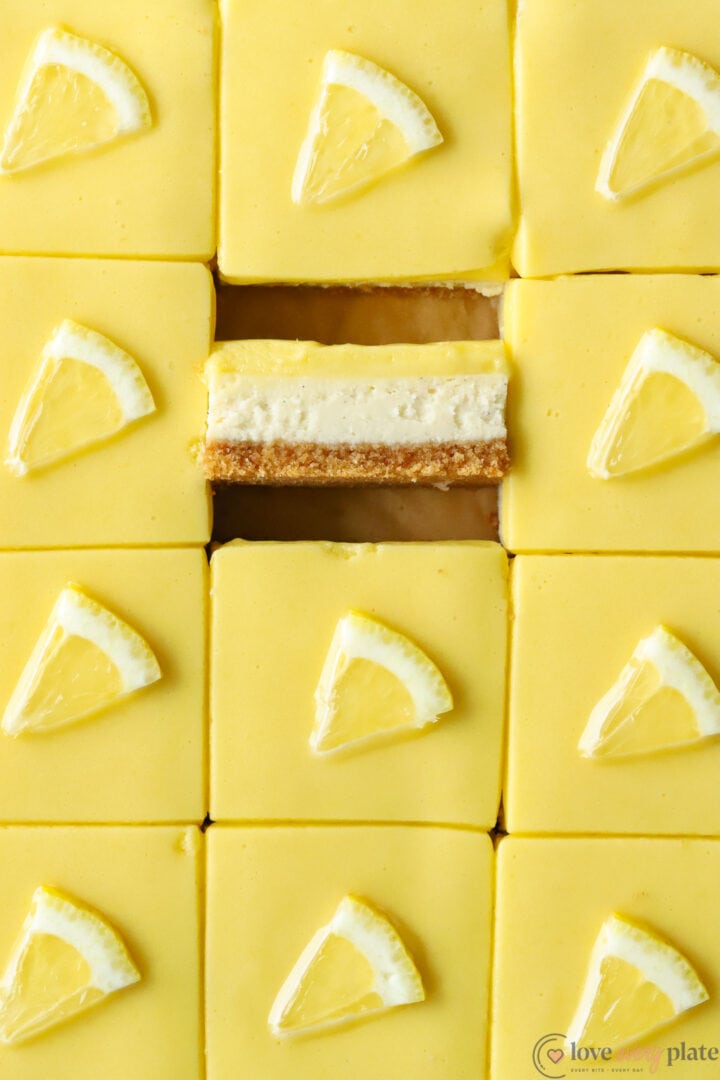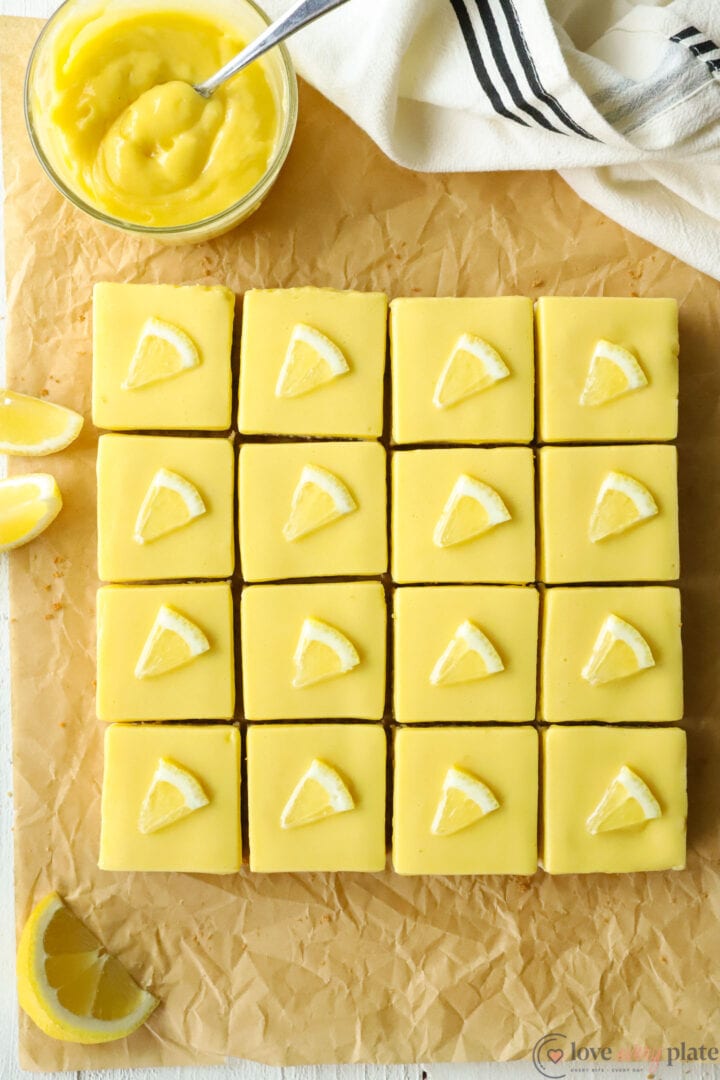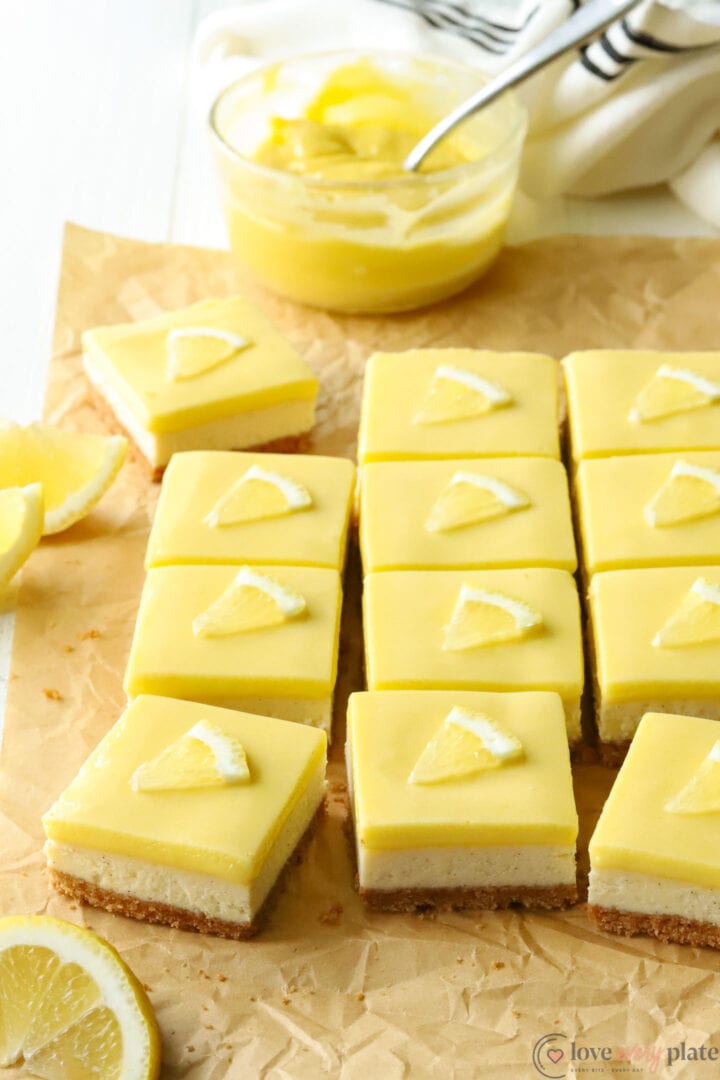Lemon Curd Cheesecake Bars
These simple squares are anything but ordinary! Thick and glossy lemon curd adds a layer of tartness against the rich vanilla filling and toasty graham crust. While there’s always a little more work involved with homemade cheesecake, these lemon curd cheesecake bars are 100% worth it.
Make the crust
With all the flavors going on in these lemon curd cheesecake bars, there’s no need to get fancy with the crust. A simple graham and brown sugar blend is all this calls for. I don’t even recommend using cinnamon grahams. You could, but the spice might get in the way of the lemon.
I played with ratios for this crust and the size of the pan, and it just so happens that one of the three packages of graham sheets (that comes in a box) is the perfect amount of crumbs for this recipe. If you’re going by numbers, that’s 9 full sheets.
Make sure to press the crust down evenly and firmly, especially into the corners, and bake until the edges are just barely beginning to brown, about 8 minutes. There’s no need to let it cool completely before you add the filling, I’ve never gotten cracks from not waiting. A full size, water bath cheesecake would be a different story, though.
Make the filling
While these lemon curd cheesecake bars are more forgiving than a traditional cheesecake, some guidelines still apply. Make sure that all of the fridge-stored ingredients are at room temperature. If the cream cheese, sour cream/crème fraiche, and eggs are cold, they’ll take longer to blend together, which means more air can get in the filling from the longer mix time. That means cracks.
Not only that, but if the ingredients are cold, that means the filling will be cold going into the warm crust and hot oven. Temperature shocks are also a sure fire way to get cracks in your cheesecake.

Make the lemon curd
After you pull the cheesecake from the oven, you can make the lemon curd. By the time the curd is done and ready to go on top of the bars, they’ll have cooled enough but still be plenty warm to match the fresh lemon curd’s warm temperature, again avoiding any cracks that could occur.
Be sure to cook the curd over medium low heat, since we’re dealing with eggs. Too hot and fast will get you lemony scrambled eggs. If that’s what you’re going for, then I hope things get better soon. The single most important thing to remember, aside from too high of heat, is to whisk constantly. Don’t stop stirring, not even for what you think might only be a second or two. If you have to stop, remove the entire saucepan from the heat until you’re ready to continue stirring.
There’s really no set time that the curd cooks for, you mostly just look for texture and thickness. Depending on how hot your stovetop is and how well your saucepan conducts heat, you can probably expect to have a finished lemon curd after 15 minutes. You want to be able to coat the back of a spoon and leave a clear trail that stays put after you swipe your finger through it.
Finish the bars
Once the lemon curd has been layered on top of the cheesecake, let the entire pan come down to room temperature. Allow it at least six hours in the fridge. I always just leave them in overnight, then there’s no guesswork as to if they’re totally set. You’ll get a better texture in the cheesecake and a cleaner set in the lemon curd. Aesthetically pleasing cut squares should count for something, right?

Store any leftover bars in the fridge for up to 5 days. I’m sure they’d last longer, but I’ve never had them hang around much after that in my house.
Print
Lemon Curd Cheesecake Bars
- Prep Time: 20 minutes
- Cook Time: 1 hour
- Total Time: 1 hour + 20 minutes
- Yield: 12 squares 1x
- Category: Dessert
- Method: Oven, Stovetop
- Cuisine: American
Description
Thick vanilla cheesecake and tangy, glossy lemon curd make these bars the perfect spring dessert.
Ingredients
For the crust:
- 1 cup graham cracker crumbs
- 2 TB light brown sugar, packed
- 1/8 tsp salt
- 3 1/2 TB unsalted butter, melted
For the cheesecake filling:
- Two 8 oz packages full fat cream cheese, room temperature
- 1/3 cup sour cream or crème fraiche, room temperature
- 2 TB all purpose flour
- 1/3 cup granulated sugar
- 1/8 tsp salt
- 2 large eggs, room temperature
- 1 TB vanilla bean paste, or vanilla extract
For the lemon curd:
- 6 egg yolks
- 1 cup granulated sugar
- 1/4 cup lemon zest (from 2-3 lemons)*
- 1/2 cup fresh lemon juice
- 1/2 cup unsalted butter, cold and cubed
Instructions
- Make the crust. Preheat the oven to 350F, and line a 9 inch square pan with parchment paper. If the parchment doesn’t cover the sides, use butter to grease them so that the cheesecake bars lift out better. Set the prepared pan aside.
- Combine the graham sheets, light brown sugar and salt in the bowl of a food processor and pulse until very finely ground. Try to get rid of any bigger chunks, or they won’t compact as easily in the pan. Stop the food processor and add the melted butter. Pulse again until completely moistened and combined.
- Press the crust mixture evenly into the bottom of the prepared pan, making sure to really press down over the entire square. Bake at 350F for 10 minutes and remove from the oven. Reduce the oven temperature to 325F. Allow the crust to cool while you make the cheesecake filling.
- Make the cheesecake filling and bake. Wipe out or wash the food processor bowl and blade. Add the cream cheese, sour cream/crème fraiche, flour, sugar and salt, and pulse until mostly blended and smooth, no longer than 10 seconds. Scrape down the bowl, and add one of the eggs. Pulse for another couple seconds until combined. Repeat with the second egg and vanilla, making sure that there are no lumps of plain cream cheese in the filling.
- Pour the filling into the crust, and bake at 325F for 25-30 minutes. When you pull the cheesecake from the oven, there should be only a slight jiggle in the center, and the edges should be set. Set the finished cheesecake aside while you make the lemon curd.
- To make the lemon curd, whisk the egg yolks, sugar and zest together in a medium saucepan until thick and pale. Add the lemon juice and whisk until smooth.
- Whisking constantly over medium/low heat, gently cook the lemon curd until it has thickened and the whisk leaves trails, about 10-15 minutes. Be sure to continuously scrape the sides and bottom of the saucepan as the curd cooks to prevent the eggs from scrambling. It’s normal to get a few tiny chunks of cooked egg, so don’t worry if you see them.
- Once the curd has thickened, it should be able to coat the back of a spoon and stay in place when you swipe your finger through it. Pass the thickened curd through a fine mesh sieve to remove the zest and any stray pieces of cooked egg.
- Add the cold chunks of butter to the strained curd, and whisk continuously until the butter has melted and blended in. The lemon curd should be thick and shiny. Immediately pour over the warm cheesecake bars and smooth into an even layer.
- Allow the finished bars to come to room temperature before refrigerating. Allow to chill for at least 6 hours, preferably overnight. Any leftovers can be refrigerated for up to 5 days.
Notes
*This measurement can vary. I just zest the lemons I use for the juice, which usually ends up being about 2-3 large lemons. Feel free to add as much zest as you prefer, since it gets strained out at the end.
Nutrition
- Serving Size: 1 square
- Calories: 368
- Sugar: 25.9 g
- Sodium: 127.8 mg
- Fat: 17.5 g
- Saturated Fat: 9.7 g
- Trans Fat: 0 g
- Carbohydrates: 47.8 g
- Fiber: 1.3 g
- Protein: 5.7 g
- Cholesterol: 159.7 mg
Recommended for this recipe:
 Buy Now →
Buy Now →  Buy Now →
Buy Now → 



